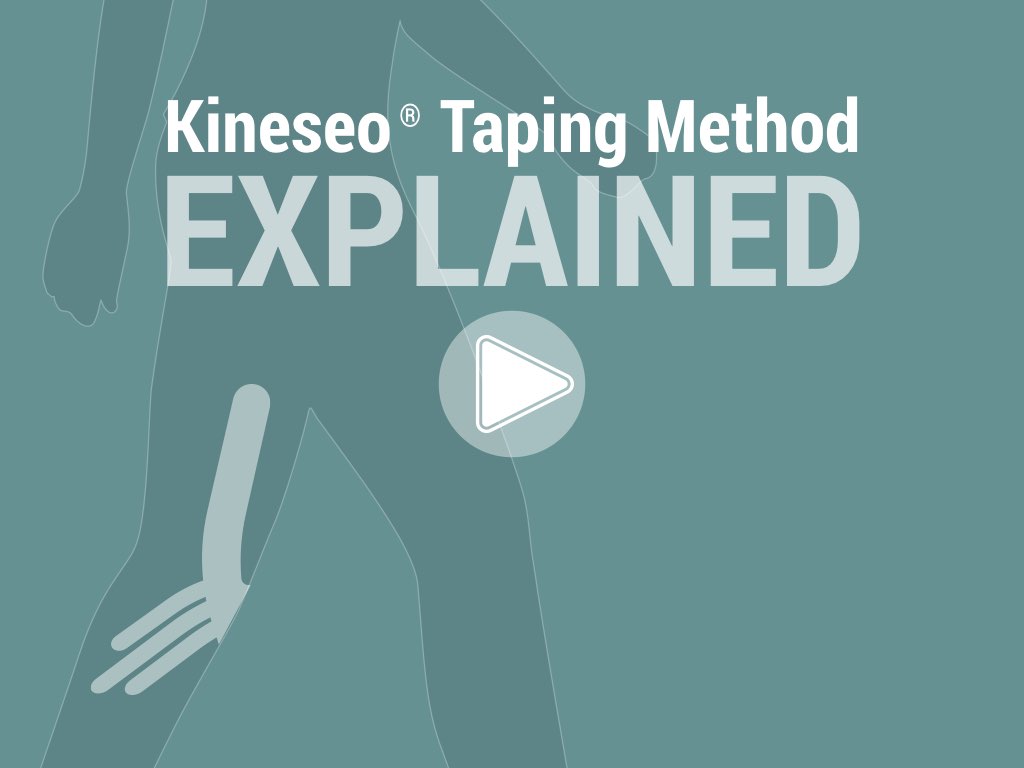Understanding the Kinesio Taping Method
What is Kinesio Taping therapy?
Kinesio taping therapy is a therapeutic technique using special elastic tape on the skin to support patients in getting through their daily activities while rehabilitating their injuries and other conditions. Also known as KT tape, it was Developed by Dr. Kenzo Kase in the 1970s, to reduce pain and inflammation, lessen muscle discomfort, and provide stability to both muscles and joints without restricting range of motion. Kinesio taping also has positive effects on the skin, lymphatic, and circulatory systems, while reducing pressure in tissues.
Is Kinesio tape just for athletes?
No. Kinesio taping may be used on populations ranging from pediatric to geriatric to treat virtually any clinical condition. Even people who drive long distances or sit at a desk all day, for example, stand to benefit from Kinesio taping. Kineseo tape is light weight, non-restrictive, and comfortable to wear. It can be applied in hundreds of ways and has the ability to rework the neuromuscular system, enhance performance, prevent injury, promote good circulation and healing, and assist in returning the body to optimal functionality. Kineseo taping method is used by physical therapists to treat a variety of conditions and many common injuries.
Is Kinesio taping therapy right for me?
If you have an injury or condition that results in pain, swelling, loss of motion, or muscle spasm your physical therapist may recommend using kinesiology tape to help treat your problem. There are many different uses for kinesiology tape. Your physical therapist can assess your current situation and injury to decide on the best use of the tape. Some common uses of kinesiology tape include:
- common sports injuries
- performance enhancement
- carpal tunnel syndrome
- muscle spasms
- neck / back pain
- knee pain / conditions
- shoulder instability
- foot problems
- IT band friction syndrome
- swelling management
- scar tissue management
Kinesio tape vs athletic tape - what's the difference?
Kinesio tape is not just a fancy form of athletic tape, there are many differences between the two. Athletic tape is used for support and to limit motion, and kinesiology tape is used to facilitate motion and inhibit pain and spasm. Kinesiology tape is a flexible material that moves when you move; athletic tape is relatively inflexible. Kinesiology tape helps to improve lymph transport and increase circulation. The tight binding nature of athletic tape serves to decrease circulation.
What does it feel like to wear Kinesio tape?
Kinesio tape is comfortable to wear and moves with your body. Most patients will feel more supported, have less pain, and better range of motion during their daily activities or athletic activities while wearing Kinesio tape. Additional features include:
- latex-free/hypoallergenic
- safe for sensitive skin
- can be worn for 3-5 days
- lightweight, non compression
- water-resistant
- non-restrictive
Kinesio Taping for Physical Therapy in Washington DC
At Release physical therapy, our clinicians are trained to determine which specific techniques will be most effective for individual patients and injuries. In some cases, Kinesio Taping will be used in conjunction with many other therapies to treat a condition. Consistent with Release Physical Therapy’s commitment to individualized care, patients are assessed through a series of orthopedic tests such as manual muscle testing, range of motion testing, and gait assessment to determine if Kinesio Taping therapy is appropriate. Set up an appointment to learn more.
What kind of injuries and conditions can be treated with Kinesio Taping?
If you have an injury or condition that results in pain, swelling, loss of motion, or muscle spasm your physical therapist may recommend using kinesiology tape to help treat your problem. There are many different uses for kinesiology tape. Your physical therapist can assess your current situation and injury to decide on the best use of the tape.
Our experienced physical therapists at Release PT can review your current conditions or injuries and recommend where Kinesio tape can help you most. Kinesio taping is versatile and can be used to treat various types of injuries and conditions, including:
Muscle Strains and Injuries: Support strained or injured muscles, reducing pain and promoting faster healing.
Joint Instabilities: For stabilizing weak or injured joints, without restricting movement.
Postural Problems: Retrains muscles for better posture, especially for those who are sedentary.
Swelling and Inflammation: Improves lymphatic drainage and circulation, while reducing swelling.
Sports Injuries: Used to prevent and treat sports-related injuries, providing support during healing.
Tendonitis and Tendon Disorders: Alleviates pain and facilitates healing in conditions like Achilles tendonitis or jumper’s knee.
Rehabilitation After Surgery: Aids in the recovery process by reducing swelling in the affected area.
Chronic Pain Conditions: Provides support and relief for lower back, knee, or foot pain.
Overuse Injuries: Helps in pain management and support for carpal tunnel syndrome or tennis elbow.
Lymphedema: Reduces lymphatic swelling and fluid build-up.
Scar Tissue Management: KT tape can help improve blood flow, facilitate lymphatic drainage, reduce tension, and support alignment. All of these things are beneficial for proper scar healing.
Kinesio tape vs athletic tape - what's the difference?
Kinesio tape is not just a fancy form of athletic tape, there are many differences between the two. Athletic tape is used for support and to limit motion, and kinesiology tape is used to facilitate motion and inhibit pain and spasm. Kinesiology tape is a flexible material that moves when you move; athletic tape is relatively inflexible. Kinesiology tape helps to improve lymph transport and increase circulation. The tight binding nature of athletic tape serves to decrease circulation.
What does it feel like to wear Kinesio tape?
Kinesio tape is comfortable to wear and moves with your body. Most patients will feel more supported, have less pain, and better range of motion during their daily activities or athletic activities while wearing Kinesio tape. Additional features include:
- latex-free/hypoallergenic
- safe for sensitive skin
- can be worn for 3-5 days
- lightweight, non compression
- water-resistant
- non-restrictive
How soon do you feel relief from Kinesio Taping?
The amount of relief Kinesio Taping provides will vary. Some feel immediate relief after application, d For others, improvement may take a few hours or days to reduce swelling and pain. While Kinesio Taping can provide quick support and pain relief, especially for muscle and joint issues, it's most effective as part of a comprehensive therapy and exercise treatment plan.
If you think Kinesio Taping could help with your condition or injury, give us a call at Release PT and speak with our physical therapy team so they can assess your specific rehabilitation needs and provide Kinesio Taping.
Is Kinesio Taping safe for everyone?
Kinesio taping is not recommended for people with skin sensitivities, adhesive allergies, certain skin conditions, people who have deep vein thrombosis, severe varicose veins, significant lymphedema, or cancer. Pregnant women should consult their physicians before using it. It should not be applied over open wounds or infected areas. The elderly or those with fragile skin should be cautious. Generally, Kinesio Taping is low-risk, safe, and beneficial when applied correctly, preferably by our licensed Release PT physical therapists.
Kinesio Taping for Physical Therapy in Washington, D.C.
At Release physical therapy, our clinicians are trained to determine which specific techniques will be most effective for individual patients and injuries. In some cases, Kinesio Taping will be used in conjunction with many other therapies to treat a condition. Consistent with Release Physical Therapy’s commitment to individualized care, patients are assessed through a series of orthopedic tests such as manual muscle testing, range of motion testing, and gait assessment to determine if Kinesio Taping therapy is appropriate. Set up an appointment to learn more.







